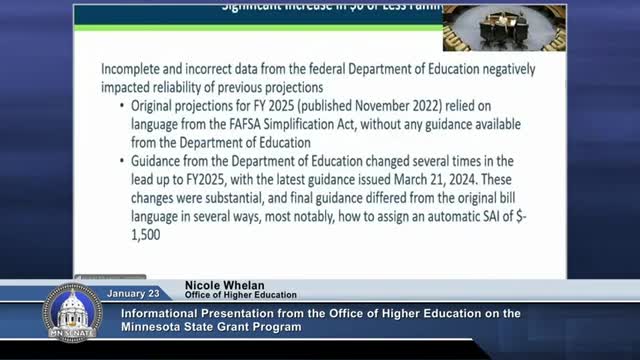State grant program faces $5 million deficit amid FAFSA changes and rising student need
January 23, 2025 | 2025 Legislature MN, Minnesota
This article was created by AI summarizing key points discussed. AI makes mistakes, so for full details and context, please refer to the video of the full meeting. Please report any errors so we can fix them. Report an error »

The Minnesota Senate Committee on Higher Education convened on January 23, 2025, to address significant changes in state grant funding driven by recent modifications to the Free Application for Federal Student Aid (FAFSA). The meeting highlighted a notable increase in the number of students applying for state grants, particularly those demonstrating high financial need.
A key discussion point was the impact of the FAFSA simplification, which has resulted in a dramatic shift in the financial profiles of applicants. According to the data presented, the percentage of students applying for state grants with a zero Expected Family Contribution (EFC) has surged from just under 30% in fiscal year 2024 to 43% in fiscal year 2025. This increase is largely attributed to the new Student Aid Index (SAI) system, which now includes many students with negative SAIs, indicating a deeper level of financial need.
The implications of these changes are significant. The Minnesota Office of Higher Education anticipates a projected deficit of approximately $5 million in the state grant program due to the increased demand for financial assistance. To manage this shortfall, the office has implemented measures such as rationing awards and establishing a FAFSA deadline of December 1, 2024, for spring awards. Officials expressed concern that some awards may not be funded at all this year, a situation described as "very rare" and indicative of the unprecedented nature of the current funding landscape.
Committee members discussed the broader context of these changes, noting that the federal government's recalibration of the FAFSA formula has led to a wider range of students experiencing increased financial need. The delay in the rollout of the new FAFSA system further complicated the situation, leaving state officials scrambling to assess the impact on funding and student support.
As the committee continues to navigate these challenges, the focus remains on ensuring that Minnesota students receive the financial support they need to pursue higher education. The upcoming February projections report is expected to provide further clarity on the funding situation and potential adjustments needed to meet the growing demand for state grants.
A key discussion point was the impact of the FAFSA simplification, which has resulted in a dramatic shift in the financial profiles of applicants. According to the data presented, the percentage of students applying for state grants with a zero Expected Family Contribution (EFC) has surged from just under 30% in fiscal year 2024 to 43% in fiscal year 2025. This increase is largely attributed to the new Student Aid Index (SAI) system, which now includes many students with negative SAIs, indicating a deeper level of financial need.
The implications of these changes are significant. The Minnesota Office of Higher Education anticipates a projected deficit of approximately $5 million in the state grant program due to the increased demand for financial assistance. To manage this shortfall, the office has implemented measures such as rationing awards and establishing a FAFSA deadline of December 1, 2024, for spring awards. Officials expressed concern that some awards may not be funded at all this year, a situation described as "very rare" and indicative of the unprecedented nature of the current funding landscape.
Committee members discussed the broader context of these changes, noting that the federal government's recalibration of the FAFSA formula has led to a wider range of students experiencing increased financial need. The delay in the rollout of the new FAFSA system further complicated the situation, leaving state officials scrambling to assess the impact on funding and student support.
As the committee continues to navigate these challenges, the focus remains on ensuring that Minnesota students receive the financial support they need to pursue higher education. The upcoming February projections report is expected to provide further clarity on the funding situation and potential adjustments needed to meet the growing demand for state grants.
View full meeting
This article is based on a recent meeting—watch the full video and explore the complete transcript for deeper insights into the discussion.
View full meeting
